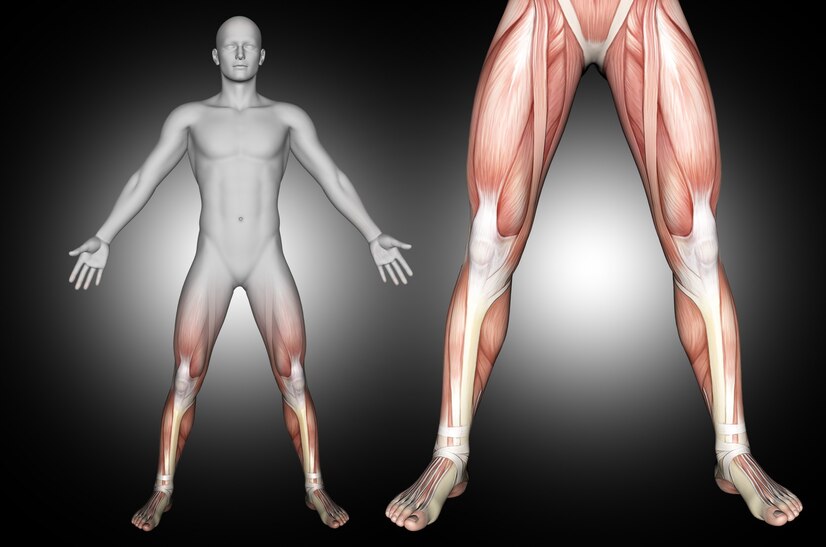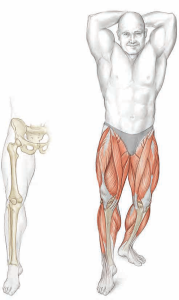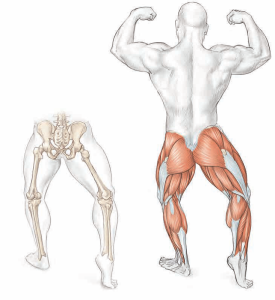Anatomy of Lower Extremity

The Anatomy of the Leg and Its Muscles
The leg is a complex structure composed of various bones, joints, and muscles that enable us to perform a wide range of movements and activities. Understanding the anatomy of the leg and its muscles is essential for athletes, fitness enthusiasts, and healthcare professionals. In this article, we will explore the anatomy of the leg, its major muscles, and their functions.
Leg Division (Upper Leg and Lower Leg):
The leg can be divided into two main parts: the upper leg (thigh) and the lower leg (calf). Let’s delve into the characteristics of each part:
- Upper Leg (Thigh): This region consists of a single bone known as the femur, which is the longest bone in the human body. The femur plays a crucial role in supporting body weight and facilitating various leg movements.
- Lower Leg (Calf): The lower leg comprises two bones—the tibia, located on the big-toe side, and the fibula, located on the little-toe side. These bones work together to provide stability and mobility to the lower leg.
The Knee Joint
The knee joint is a hinge joint formed at the junction between the femur (thigh bone) and the tibia (shinbone). This joint primarily allows two movements:
- Flexion: During knee flexion, the lower leg bends towards the back of the thigh, resulting in a folded position of the leg.
- Extension: Knee extension involves straightening the leg as the lower leg moves away from the thigh, achieving a straight leg position.
The knee joint is essential for activities like walking, running, and jumping, as it facilitates leg movement.
The Hip Joint
The hip joint is a ball-and-socket joint formed between the upper end of the femur and the pelvic bone. It allows for a wider range of movements compared to the knee joint. Six main movements occur at the hip joint:
- Flexion: During hip flexion, the thigh bends up towards the abdomen.
- Extension: Hip extension involves moving the thigh backward towards the buttocks.
- Abduction: The thighs move away from each other during hip abduction.
- Adduction: Hip adduction brings the thighs together.
- Internal Rotation: The thigh rotates inward towards the body’s midline.
- External Rotation: The thigh rotates outward away from the body’s midline.
The hip joint plays a crucial role in walking, running, dancing, and various lower body movements.
The Ankle Joint
The ankle joint is a hinge-type joint that connects the lower tibia and fibula to the talus bone in the foot. It primarily facilitates two movements:
- Ankle Dorsiflexion: During dorsiflexion, the toes lift off the floor, and the foot moves toward the shin.
- Ankle Plantar Flexion: Ankle plantar flexion involves lifting the heel off the floor as the foot moves away from the shin.
These ankle movements are vital for activities like walking, running, and pointing the toes.
Major Leg Muscles
The leg muscles play a pivotal role in leg movement, stability, and overall lower body strength. Here are some of the major leg muscles and their functions:
Quadriceps (Front of the Thigh): The quadriceps femoris, commonly known as the quadriceps, consists of four separate heads:
- Rectus Femoris: Arising from the front of the pelvic bone, it flexes the hip and extends the knee.
- Vastus Medialis: Originating from the inner edge of the femur, it extends the knee.
- Vastus Lateralis: Arising from the outer edge of the femur, it also extends the knee.
- Vastus Intermedius: Located beneath the rectus femoris, it extends the knee.
The primary function of the quadriceps is to extend the knee and straighten the leg. The rectus femoris additionally flexes the hip.
Hamstrings (Back of the Thigh): The hamstrings are a group of three muscles:
- Biceps Femoris: This muscle passes behind the outer aspect of the thigh and attaches to the fibula. It flexes the knee and extends the hip.
- Semimembranosus: It passes behind the inner aspect of the thigh and attaches to the upper tibia behind the knee. It flexes the knee and extends the hip.
- Semitendinosus: Located behind the inner thigh, it attaches to the upper tibia adjacent to the semimembranosus. Like the others, it flexes the knee and extends the hip.
The hamstrings serve dual functions, including knee flexion and hip extension.
Gluteus Maximus (Buttocks): The gluteus maximus arises from a large area on the rear of the pelvic bone, passes down behind the hip joint, and attaches to the upper femur. This powerful muscle is responsible for hip extension and is essential for movements like standing up from a seated position. Exercises such as squats, deadlifts, and lunges are effective for building the gluteal muscles.
Functional lower-leg exercises, along with the primary muscles they engage:
- Squats (Gastrocnemius, Soleus, Tibialis Anterior, Quadriceps, Hamstrings, Glutes):
- Stand with your feet shoulder-width apart.
- Lower your body by bending your knees and hips, as if sitting back into a chair.
- Keep your back straight and chest up.
- Push through your heels to return to the starting position.
- Deadlifts (Gastrocnemius, Soleus, Hamstrings, Glutes, Lower Back, Erector Spinae):
- Stand with your feet hip-width apart and a barbell in front of you.
- Bend at your hips and knees to lower your torso.
- Grip the barbell with both hands, keeping your back straight.
- Lift the barbell by straightening your hips and knees while keeping it close to your body.
- Lower the barbell back to the ground with control.
- Lunges (Gastrocnemius, Soleus, Quadriceps, Hamstrings, Glutes):
- Stand with your feet together.
- Take a step forward with one leg and lower your body until both knees are bent at a 90-degree angle.
- Push off the front foot to return to the starting position.
- Repeat on the other leg.
- Step-Ups (Gastrocnemius, Soleus, Quadriceps, Hamstrings, Glutes):
- Stand in front of a sturdy bench or step.
- Step one foot onto the bench and push through the heel to lift your body up.
- Step back down and repeat on the other leg.
- Box Jumps (Gastrocnemius, Soleus, Quadriceps, Hamstrings, Glutes):
- Stand in front of a box or platform.
- Bend your knees and jump onto the box, landing softly with your knees slightly bent.
- Step back down and repeat.
- Calf Raises on an Incline (Gastrocnemius, Soleus):
- Stand on an incline board or an elevated surface with your heels hanging off.
- Raise your heels as high as possible and then lower them below the incline level.
- Perform this exercise with both straight legs and bent knees to target different parts of the calf muscles.
- Jump Rope (Gastrocnemius, Soleus):
- Jump rope continuously, using your calf muscles to propel your body off the ground.
- Hill Sprints (Gastrocnemius, Soleus, Quadriceps, Hamstrings, Glutes):
- Find a steep hill or incline.
- Sprint uphill as fast as you can.
- Walk or jog back down to recover, then repeat.
- Running (Gastrocnemius, Soleus, Quadriceps, Hamstrings, Glutes):
- Running, especially uphill or on uneven terrain, engages the lower-leg muscles for propulsion and stabilization.
- Agility Ladder Drills (Gastrocnemius, Soleus, Ankle Stabilizers):
- Perform various agility ladder drills, such as high knees, lateral shuffles, or ladder hops, to improve lower-leg agility and coordination.
- Boxing or Kickboxing (Gastrocnemius, Soleus, Quadriceps, Hamstrings, Glutes, Ankle Stabilizers):
- These activities involve quick footwork, pivoting, and balance, which engage the lower-leg muscles for stability and power.
- Trail Hiking (Gastrocnemius, Soleus, Quadriceps, Hamstrings, Glutes, Ankle Stabilizers):
- Hiking on uneven terrain and uphill challenges the lower-leg muscles for endurance and balance.
- Basketball (Gastrocnemius, Soleus, Quadriceps, Hamstrings, Glutes, Ankle Stabilizers):
- Playing basketball involves jumping, running, and rapid changes in direction, which work the lower-leg muscles extensively.
Incorporate these functional lower-leg exercises into your workout routine to improve strength, power, stability, and overall lower-leg function. Remember to use proper form and technique to minimize the risk of injury and maximize the benefits.
